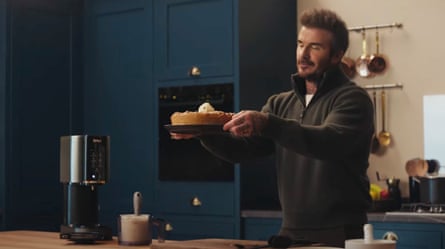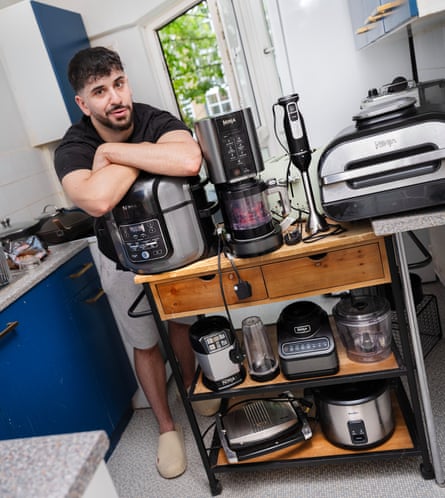I have a problem. It has spanned many years, cost me hundreds of pounds and earned the derision – and concern – of friends and family. Don’t worry: it isn’t anything sordid but it does give me an absurd number of ways to cook chicken or use up a bag of potatoes.
My poison is Ninja appliances. Anyone who walks into my tiny kitchen is taken aback by my extensive collection. My prized trio are the Foodi, the Foodi Max Health Grill and Air Fryer and the Creami, which collectively give me the ability to air-fry, grill, sear, roast, pressure-cook, slow-cook, steam or even dehydrate my dinner, and transform a frozen mishmash of protein powder, yoghurt and sweeteners into an ice-cream-like dessert.
It doesn’t stop there. I also own a Ninja blender, food processor and hand blender. While less flashy, they have survived my unwise attempts to mince a fully intact topside of beef and turn avocado stones into “detox dust” for an ill-fated “glow-up” smoothie.
I am far from the only person who has been taken in by Ninja fever. Global sales of its products reached almost $2.9bn in 2024, a 38% jump from nearly $2.1bn the year before. With more than 50 Ninja kitchen products available in Britain, the UK is now the second largest market for their maker, the US-based appliance company SharkNinja. It is a remarkable feat considering that a decade ago the brand was nearly unknown in the UK.
It was the air fryer that changed that, particularly the two-drawer food crisper, which hit the shops in 2020. Launching at £179.99 in the UK ($179.99 in the US), it was swiftly stocked in high-street big hitters including Argos and John Lewis. It soon took the UK, and the world, by storm.

In 2023, John Lewis named the Ninja air fryer as one of its “products of the decade”. On Amazon, Ninja’s products dominate the air-fryer bestsellers charts, holding four of the top five spots in the UK and the US.
Ninja’s next mega-success was the Creami, which promises to turn a tub filled with ingredients of your choosing into a creamy, cold dessert. It launched in 2021 in the US at $179.99 and soon became a viral hit on social media. By 2022, Ninja claimed it was America’s “No 1 ice-cream maker”, based on sales data from market research firm NPD Group. On TikTok, the hashtag “#ninjacreami” has 244m views as people have flocked to the platform to show off their recipes. Strained yoghurt and fruits are common options, but others have opted for more off-piste creations, including a baked bean “ice-cream”.
The Ninja Slushi (£349.99 in the UK, $349.99 in the US), which allows you to make slushies and cocktails at home, is the brand’s latest success, selling out 15 times on its release in the US. On the back of that hit, SharkNinja was this year named as one of Time Magazine’s top 100 companies, joining the likes of Netflix and Amazon.

The brand has also done a remarkable job of getting A-listers to plug its products. Kris Jenner’s Instagram featured a sponsored post of her singing the device’s praises. David Beckham is a global brand ambassador for Ninja and in one advert showed off some of his own culinary quirks – which included using his Ninja Double Stack air fryer (£229.99) to cook carrots whole, including the green tops, and using the Woodfire outdoor oven (£349.99), which triples up as an oven, pizza oven and BBQ smoker, inside his kitchen. Viewers of the film F1: The Movie, starring Brad Pitt, will see SharkNinja’s product placement throughout – from its logo stamped on race cars to Ninja gadgets on show in swanky kitchens.
In an interview with Ad Week in March, SharkNinja CEO Mark Barrocas said the company spends much of its $700m advertising budget on social media. Influencers play such a strong role in promoting the Creami, he said: “We virtually don’t invest any more advertising on [it].” The company has also worked hard to get its products in the hands of so-called “microinfluencers” who have “great, authentic followings with smaller niche groups”. It is, simply, word of mouth for the social media age.
But this kind of business relies on innovation. SharkNinja pours money into research and development, with a budget that rose to $341.3m in 2024, up 37% from 2023. It has a team of more than 1,100 engineers and designers in the UK, US and China, is typically working on 60 products at any one time and launches about 25 new products a year.
Some of these are better value than others, according to Natalie Hitchins, head of home products and services at Which? “Ninja continues to be a popular brand with customers, and when it comes to air fryers, blenders and multicookers, our testing has found that this is mostly well deserved,” she says. “However, prices can reach more than £300 so it certainly isn’t the cheapest. And if you’re looking for an ice-cream maker or mini-oven, we’ve found that there are other brands that perform better and cost less, so it’s worth looking elsewhere.”
Like me, Rhianne Crozier has a kitchen full of Ninja appliances. Her love of the brand started six years ago. After she moved into her new home with her husband, her parents gave her a Ninja air fryer as housewarming gift.
Now she owns more than 10 Ninja gadgets. They include the Creami, Slushi, the Luxe Café coffee machine (£549.99) – a high-end brewer that allows you to make espressos, cold brews and cafe staples such as lattes and cappuccinos – and the Ninja Speedi multicooker (£229.99), a combined steamer and air fryer designed for one-pot meals. In total, she has spent about £2,000 on Ninja products.
The 28-year-old content creator, who shows off her dishes on TikTok under the name Home With Rhianne, has two children. “I’ve cooked meals in about 15 minutes. It’s great when you’ve got hungry kids,” she says. “Before I would stay in the kitchen for hours.”
She hasn’t touched her pans or oven in months. “It’s more convenient to just put it in, close it, take it out. They’re easy to clean afterwards too,” she says.
But does the success of Ninja tell us something more uncomfortable about how we live today? Pen Vogler, author of Scoff: A History of Food and Class in Britain, says “these very speedy innovations” are part of a consumer culture where “there has to be something new constantly”.
My personal journey into Ninja-obsession did start with need. When I moved into my small flat, it was unfurnished. After buying something to sleep on (my bed) and something to watch (my TV), money was too tight to deck out my kitchen with pots, pans and baking trays. Instead, I opted for a Ninja Foodi, which set me back just over £100. It allowed me to sear, pressure-cook and air-fry my food without having to buy loads of extra equipment, and it was much quicker than using the oven. I’m not the only person who struggles for space – one study by the University of Reading found that the living space of the average private renter in Britain shrank from 31 sq metres in 1996 to 25 sq metres in 2017; and families are renting increasingly smaller homes as the cost of living soars.
Vogler says that in the Victorian era, living space was also very tight, and cooking gadgets were also enormously popular. She points to Charles Dickens, who in his 1841 novel The Old Curiosity Shop described a silver “temple” with four chambers. In one, an egg was placed and in another, some coffee was poured. Raw steak and water were put in and, after the machine worked its magic, “breakfast was ready”. It is, says Vogler, “like a kind of Victorian air fryer”. A lack of living space means people will “try to use what technology they have available to answer the problems of how to cook. What Ninja is doing now is just a continuation of something that has been happening for centuries. Technology comes along and it finds a solution to our domestic problems.”
What started for me as a solution to a space problem soon became something else. I became obsessed with the Ninja brand, eagerly following its social media to see what device it could bring out to tempt me with next. Recently, however, the shine has worn off. While the Slushi has been a sensation, it lacks many things that have previously sold me on the brand. Yes, it allows you to make slushie drinks and cocktails, but there are major setbacks. It takes at least half an hour to produce a drink, lacks that “I can see myself using this every day” factor and, most importantly, doesn’t seem to have many health advantages, as sugar must be used for most drinks to work in the machine.

“Health is becoming a really important part of our cooking technology,” says Vogler. And Ninja’s success has certainly played on our worries about ultra-processed foods. “There’s a large element of anxiety around industrial food that is sending people back to try to make it for themselves,” says Vogler, which “air fryers and kitchen gadgets will do well from. If people are moving back to cooking, they will always want a fast and easy way to do it.”
Ninja has adapted to 2020s living, but how have the gadgets changed us? Before the air fryer, there was the microwave. Both have been accused of tarnishing the culinary arts, but Vogler says some of our most beloved dishes were born out of new kitchen technology.
For her, the air fryer has an unlikely relative. “Cast iron ovens first came in about 300 years ago. It was a massive new technology and is also when our era of home-baking took off,” she says. It ushered in some of our favourite dishes, including eccles cakes and baked tarts.
Judy Joo, TV chef and owner of the London-based Korean restaurant Seoul Bird, says kitchen gadgets can be “great”, but they have limits. “Sometimes you just want to cook something the way it was intended,” she says.
That includes being able to watch what’s going on. With Ninja appliances, particularly the air fryers and multi-cookers, you end up shoving something in a draw or sealing a lid. For Joo, visibility is key. “You should be able to see food cooking and changing versus something that you say goodbye to and open up the door once it’s ready,” she says. “You lose control of the cooking process.”
And, she says, air fryers will never fully replicate something deep-fried, like chicken. “It’s a compromise,” she says. “You don’t get things as crispy. It’s crispy-ish, but it’s definitely not the same. You could tell the difference 100%.”
For her, nothing quite beats the kitchen classics, particularly the satisfaction of “getting out a regular pot or pan, drizzling oil, hearing the sizzle and cracking an egg”. The humble frying pan is much more versatile than it’s given credit for, considering you can “glaze, simmer and saute” in it, she says. “You can’t deglaze in an air fryer.”

 3 months ago
133
3 months ago
133

















































